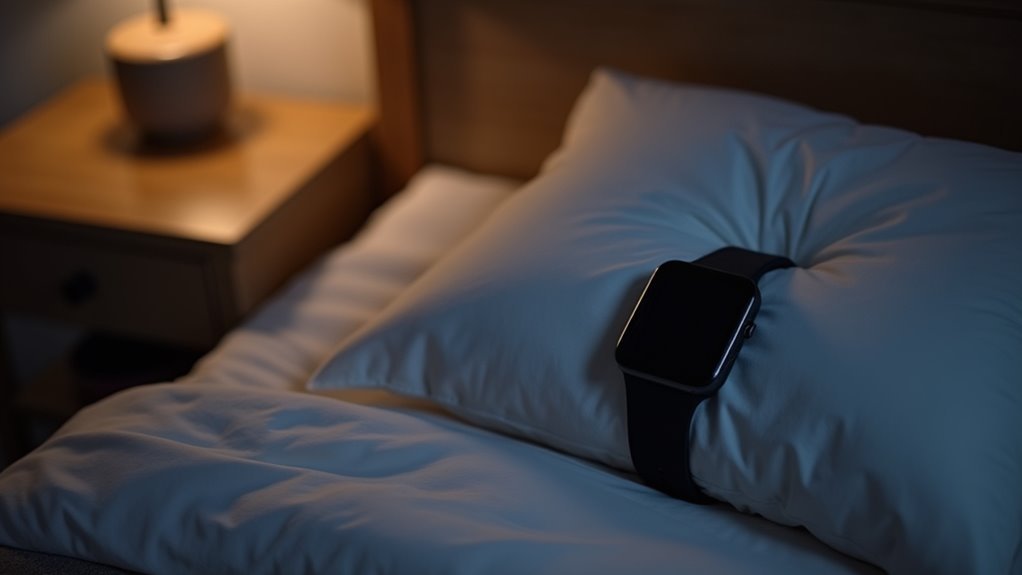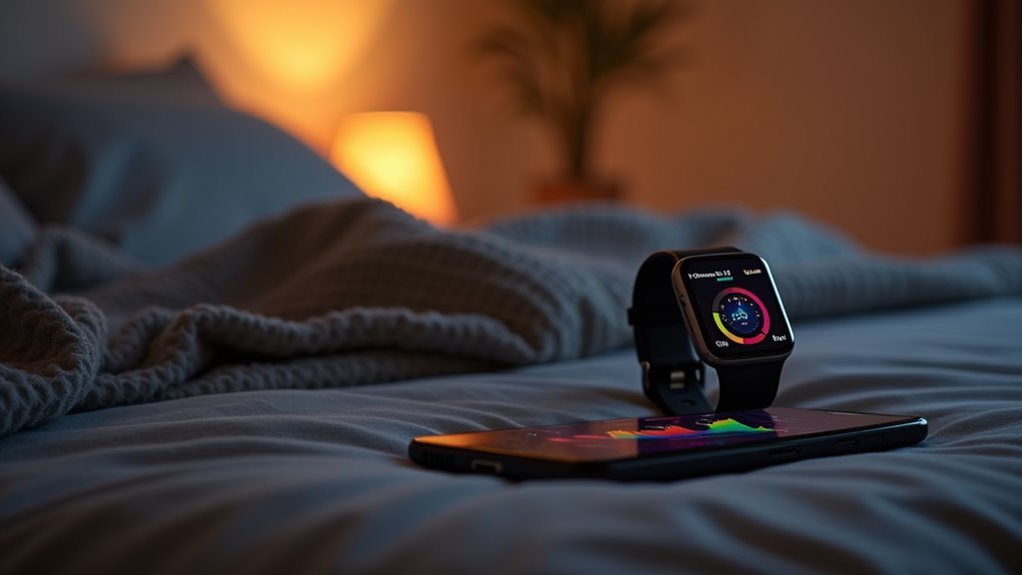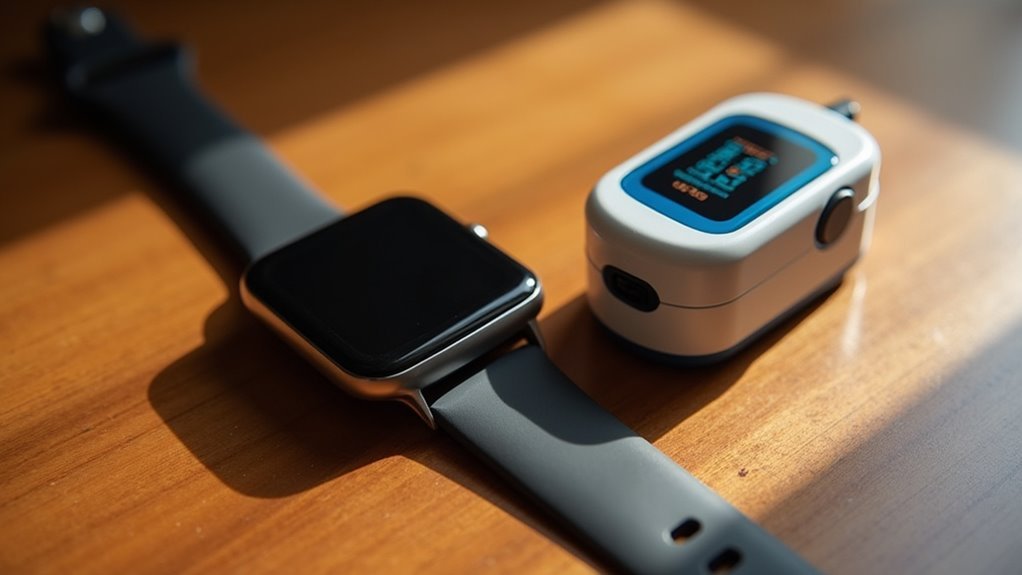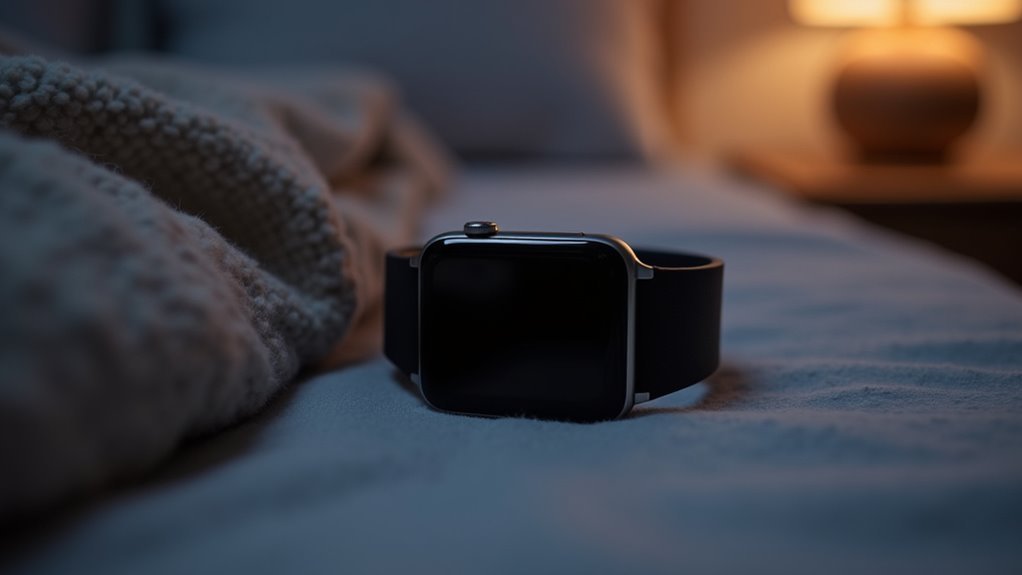Your Fitbit tracks overnight blood oxygen levels using red and infrared light sensors that measure oxygen saturation through your skin. You’ll need a compatible device like the Versa 3 or Sense with the SpO2 app installed. Normal levels range from 95-100%, while consistent readings below 92% warrant medical consultation. Wear your device snugly, keep it charged, and sync each morning to view data in the Health Metrics tile. Understanding these measurements and optimization techniques can greatly improve your sleep health monitoring.
How Fitbit Measures Blood Oxygen Levels During Sleep

When you’re sleeping, your Fitbit uses sophisticated red and infrared light sensors on the device’s back to measure your blood oxygen saturation levels.
These sensors emit light onto your skin and blood vessels, then analyze the color of light that bounces back to determine how much oxygen’s in your blood.
Light sensors detect oxygen levels by measuring how different wavelengths reflect off your blood vessels beneath the skin.
Your device processes this data using advanced algorithms to track your nightly average SpO2 levels, creating trends you can monitor in the Fitbit app.
The system also calculates your Estimated Oxygen Variation (EOV), which approximates changes in your blood oxygen levels throughout the night.
This helps you detect variations during sleep that might indicate changes in your fitness and wellness, giving you valuable insights into your overnight breathing patterns. While Fitbit devices demonstrate acceptable accuracy for sleep monitoring in general use, it’s important to understand their limitations for clinical assessment.
Setting Up Your Fitbit for Overnight SpO2 Monitoring
Before you can track your overnight blood oxygen levels, you’ll need to guarantee your Fitbit device supports SpO2 monitoring and meets the necessary requirements.
Compatible devices include Fitbit Versa 3, Sense, and Inspire models running Fitbit OS 5.1 or higher. Update both your device firmware and Fitbit app to the latest versions.
Start by pairing your Fitbit with your smartphone and creating a Fitbit account.
Navigate to the device Gallery through the “Today” tab and search for “SpO2” apps or watch faces. Install the SpO2 app if it’s not preloaded, granting all requested permissions.
Ensure sleep tracking is enabled since SpO2 monitoring runs automatically during sleep.
Wear your Fitbit snugly on your wrist and charge it fully before bedtime to avoid data collection interruptions. Your device uses red and infrared sensors to measure blood oxygen saturation throughout the night.
Understanding Your SpO2 Data in the Fitbit App

Once you’ve synced your device after waking up, you’ll find your SpO2 data in the Health Metrics tile of your Fitbit app.
Simply tap the tile and swipe up to locate the SpO2 section where you can view your overnight blood oxygen measurements.
The app displays your data as visual graphs with color-coded lines that help you quickly identify patterns and variations in your oxygen saturation levels. Green lines indicate small variations while yellow marks show larger fluctuations in your readings.
Accessing Health Metrics Tile
To access your SpO2 data within the Fitbit app, you’ll need to navigate to the Health Metrics tile, which serves as your central hub for viewing blood oxygen saturation trends and other vital health measurements.
Start by tapping the “Today” tab in your Fitbit app to reach the main dashboard. Look for the “Health Metrics” tile among your displayed options. If you don’t see it, tap “Edit” to add it from the tile library.
This customizable tile aggregates multiple health metrics in one convenient location, making it easy to review your overnight SpO2 levels alongside other significant data. A Premium subscription is necessary to view SpO2 trends in the Health Metrics tile. You can rearrange or remove tiles as needed to personalize your dashboard experience.
Interpreting Trend Patterns
Your SpO2 data reveals meaningful patterns when you examine it over weeks and months rather than focusing on individual nights. The Fitbit app’s visualization tools help you identify significant changes by comparing current readings to your personal baseline. High variation graphs indicate sleep disturbances, while consistent patterns suggest stable respiratory function.
| Pattern Type | What It Indicates | Action to Reflect On |
|---|---|---|
| Gradual decline | Potential health changes | Consult healthcare provider |
| High variation | Sleep disturbances | Review sleep environment |
| Stable readings | Good respiratory health | Continue monitoring |
Factors like altitude, activity levels, and overall health influence your readings. By tracking these trends alongside other metrics like heart rate variability, you’ll gain thorough insights into your wellness status and sleep quality over time. The oxygen variation graph displays fluctuations but does not provide exact time or saturation levels for specific moments during your sleep.
Normal SpO2 Ranges and What Your Numbers Mean
Now that you’re familiar with accessing your SpO2 data, you’ll need to understand what those numbers actually mean for your health.
Your Fitbit readings should typically fall within the normal range of 95-100%, but it’s essential to recognize when fluctuations might indicate a potential concern.
Let’s explore how to establish your personal baseline, interpret the variations you’ll see, and identify the warning signs that warrant medical attention. Keep in mind that your pulse oximeter may have a 2-3% margin of error, so minor fluctuations in your readings are normal and expected.
Healthy SpO2 Baseline Levels
When you’re checking your SpO2 readings on your Fitbit, understanding what constitutes a healthy baseline becomes essential for interpreting your data accurately. Your normal SpO2 levels should typically range from 95% to 100%. Even if you’re over 70 years old, you’ll still want to maintain readings around 95% or higher.
However, your baseline may differ if you have lung conditions like COPD. Various factors can influence your readings, including smoking, which creates falsely high measurements due to carbon monoxide exposure.
Higher altitudes, sleep patterns, body position, medications, and underlying conditions like asthma or heart problems can also affect your levels. If your SpO2 readings consistently show 92% or lower, you should contact a healthcare provider for proper evaluation.
Remember that your Fitbit’s pulse oximeter has a 2-3% error margin compared to arterial blood gas tests, so consider this when evaluating your overnight trends.
Interpreting Your Fitbit Readings
Knowing these baseline ranges sets the foundation, but understanding what your specific Fitbit numbers actually mean requires recognizing the device’s limitations and capabilities. Your wrist-based SpO2 readings provide estimates, not clinical-grade measurements like fingertip pulse oximeters deliver.
| SpO2 Reading | Interpretation | Action Needed |
|---|---|---|
| 95-100% | Normal range | Monitor trends |
| 90-94% | Below normal | Consider validation |
| Below 90% | Potentially concerning | Consult healthcare provider |
| Highly variable | Device/fit issues | Check placement and battery |
Focus on overnight trends rather than single readings, since sleep posture, movement, and wrist blood flow create natural variability. Your device isn’t FDA-approved for medical diagnosis, so use it as a wellness indicator. If readings persistently fall below normal or show unusual patterns, validate with a fingertip oximeter and consult your healthcare professional. Keep in mind that reflectance-based measurements from your wrist-worn Fitbit may show different results compared to transmittance measurements from fingertip devices, which are historically more accurate.
When Numbers Signal Concern
While your Fitbit provides helpful SpO2 estimates, certain readings demand immediate attention regardless of the device you’re using.
If your overnight SpO2 levels consistently drop below 95%, you’re entering the hypoxemia range that requires medical evaluation. Readings between 91% and 94% suggest potential health issues warranting a healthcare consultation. However, levels at or below 90% constitute a medical emergency demanding immediate professional care.
Remember that Fitbit’s measurements aren’t as precise as medical-grade equipment, typically carrying a 2-4% margin of error.
Don’t panic over occasional low readings, but pay attention to patterns. If you’re consistently seeing concerning numbers, especially with symptoms like shortness of breath or fatigue, contact your healthcare provider. Watch for signs of cyanosis, which appears as a bluish color in your skin, fingernails, and lips, indicating severely low oxygen levels.
Your device serves as an early warning system, not a diagnostic tool.
Accuracy Limitations of Consumer Wearable Devices
Although Fitbit devices offer convenient SpO2 monitoring, several factors can greatly impact their accuracy compared to medical-grade pulse oximeters.
Your skin thickness, circulation quality, and pigmentation all affect how light penetrates and reflects back to the device’s sensors. If you’re a smoker, readings may be less reliable due to altered hemoglobin levels.
Skin thickness, circulation, and pigmentation directly influence how accurately your Fitbit’s sensors can measure oxygen levels through light reflection.
Environmental conditions also matter—altitude changes, temperature extremes, and movement during sleep can disrupt measurements.
Your Fitbit’s hardware and software algorithms differ considerably from medical equipment, leading to potential inconsistencies. The device may struggle with data collection if you have poor circulation or darker skin tones, sometimes overestimating oxygen saturation levels. According to health experts, readings can be off by 4 percentage points due to various individual factors.
These limitations don’t make your Fitbit useless, but you shouldn’t rely on it for medical decisions.
Comparing Fitbit SpO2 Readings to Medical Oximeters

When you compare your Fitbit’s SpO2 readings to medical-grade pulse oximeters, you’ll likely notice some significant differences. Users commonly report Fitbit readings that are 4-5% lower than medical devices, which can be concerning when monitoring your health.
Several factors contribute to these discrepancies:
- Measurement location – Your Fitbit measures from your wrist, while medical oximeters use fingertip readings, which are technically more accurate.
- Timing differences – Fitbit collects data overnight during sleep, whereas medical devices provide instant readings at any time.
- Skin tone impact – Darker skin tones may experience greater inaccuracies with Fitbit’s sensor technology compared to clinical-grade equipment. Recent studies indicate that increased skin pigmentation absorbs more light, which can lead to distorted SpO2 readings.
Best Practices for Reliable Overnight Measurements
Getting accurate SpO2 readings from your Fitbit requires more than just strapping it on before bed. You’ll need to position it properly, maintain consistent conditions, and establish good data collection habits.
Wear your device snugly but comfortably, positioning it about one finger width above your wrist bone. Guarantee continuous skin contact throughout the night, as gaps interrupt data collection. Clean both your wrist and band before sleep to remove sweat or moisture.
| Best Practice | Why It Matters |
|---|---|
| Fully charge before bed | Prevents data interruption from dead battery |
| Maintain consistent room temperature | Extreme temperatures affect circulation and accuracy |
| Sync device each morning | Updates SpO2 metrics and identifies data gaps |
Track nightly for trend analysis rather than relying on single readings, and consult medical professionals for concerning patterns. Be aware that some Fitbit models may have hardware implementation challenges that could affect feature availability or performance.
Interpreting Long-Term SpO2 Trends and Patterns
While individual SpO2 readings provide snapshots of your oxygen saturation, tracking these measurements over weeks and months reveals meaningful patterns that can guide your health decisions.
Your Fitbit’s long-term data helps identify trends that single measurements can’t capture, making it easier to spot concerning changes or improvements in your respiratory health.
When analyzing your SpO2 trends, focus on these key indicators:
- Consistent drops below 90% – May signal underlying conditions like sleep apnea requiring medical evaluation
- Gradual declining patterns – Could indicate developing respiratory or cardiac issues that need attention
- Environmental correlations – Notice how altitude changes, air quality, or seasonal factors affect your readings
Remember that natural fluctuations occur based on sleep stages and body position, but persistent concerning patterns warrant discussion with your healthcare provider. Advanced AI-enhanced systems can now provide real-time SpO2 monitoring with adaptive features that address motion artifacts and demographic variations for more accurate long-term tracking.
When to Consult Healthcare Professionals About Your Results
Your Fitbit’s SpO2 data serves as valuable health information, but knowing when these readings require professional medical evaluation can protect your well-being.
You should seek medical attention if your SpO2 levels consistently remain below 90%, as this may indicate hypoxemia or other serious conditions. Consult healthcare professionals immediately if you’re experiencing respiratory symptoms like shortness of breath, wheezing, or coughing alongside low readings.
Any new symptoms such as chest pain or dizziness warrant evaluation. Remember that Fitbit devices aren’t medical-grade equipment, so they’re less reliable for precise diagnosis.
Healthcare professionals can properly interpret your SpO2 trends, provide appropriate medical advice, and determine if further testing is necessary for your specific situation. Keep in mind that normal blood oxygen saturation levels typically range between 95–100%.
Frequently Asked Questions
Can I Track Spo2 During Daytime Naps or Only Overnight Sleep?
You can only track SpO2 during overnight sleep with Fitbit devices. They’re specifically designed for nighttime monitoring and don’t automatically detect or measure blood oxygen levels during daytime naps.
Will Sleep Position Affect My Fitbit’s Spo2 Readings Accuracy?
Sleep position can affect your Fitbit’s SpO2 accuracy if it causes device slippage or poor skin contact. You’ll get better readings by ensuring your device fits snugly and securely throughout the night.
How Long Does Fitbit Store My Historical Spo2 Data?
Fitbit doesn’t explicitly state how long they’ll store your historical SpO2 data. You can access recent sleep sessions in the app and export all your data for personal backup through settings.
Can Medications or Supplements Impact My Overnight Spo2 Measurements?
Yes, medications like opioids, hypnotics, and sedatives can considerably lower your overnight SpO2 levels. Limited data exists on supplements’ effects, but some may indirectly impact readings through sleep quality changes.
Does Altitude or Travel Affect Fitbit Spo2 Baseline Readings?
Yes, altitude and travel greatly affect your Fitbit SpO2 baseline readings. Higher altitudes reduce oxygen availability, causing temporary drops in your readings until you’ve acclimatized over time.
In Summary
You’ve learned how to maximize your Fitbit’s SpO2 monitoring capabilities for better sleep health insights. Remember that while these readings provide valuable trends, they’re not medical-grade measurements. Use your overnight data to identify patterns and potential concerns, but don’t rely solely on consumer devices for health decisions. When you notice consistent irregularities or have breathing concerns, consult your healthcare provider who can perform proper diagnostic testing.





Leave a Reply